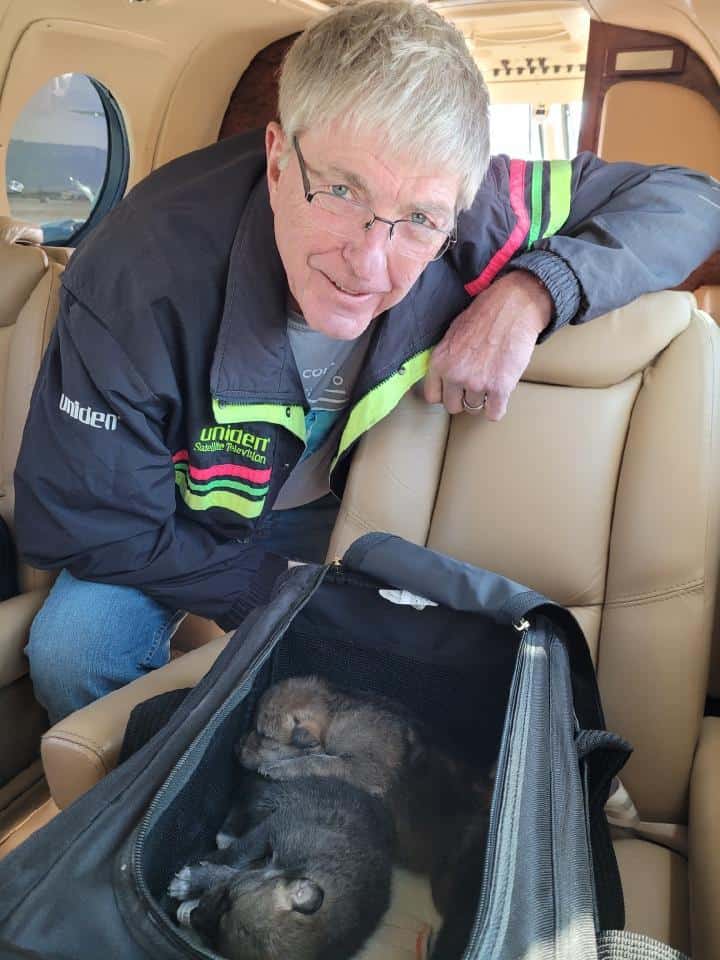This spring, Sedona pilot Mike Schroeder flew from the Sedona Airport to the Spirit of St. Louis Airport in St. Louis. He checked into a hotel to get some sleep, because his St. Louis passengers — five 11-day-old Mexican wolves — needed to leave at 5:30 a.m. for their flight to eastern Arizona.
For the second consecutive year, Schroeder contributed his plane and flight skills to the multi-agency effort to place captive-bred Mexican wolves into wild dens in Arizona and New Mexico.
Schroeder became involved with the Mexican Gray Wolf Recovery Program as a volunteer with LightHawk, an organization that connects volunteer pilots with conservation projects in need of air support.
This year, with slightly relaxed COVID restrictions, two animal handlers from the Endangered Wolf Center in St. Louis flew part of the way with Schroeder so they could give the pups a belly-full of food mid-flight, which would save critical time on the ground when wildlife managers were locating a suitable den to place the pups in.

wolf pups he flew from St. Louis to Arizona this spring
as a volunteer with LightHawk, a conservation flying
organization. Photo courtesy Mike Schroeder.
Flying endangered animals is pretty serious business. Schroeder had to get a certification to transport the pups and carry a permit during the flight. He also carried a list of veterinarians working along the flight path who he could contact if the plane had to land somewhere outside their itinerary.
En route to Springerville, Schroeder landed in Albuquerque, N.M., to refuel and drop off the handlers — so they could catch a commercial flight back to St. Louis — and the stop provided one of the tenser episodes of the trip, as Schroeder had to land his 10-seat Beechcraft in a crosswind gusting up to almost 40 knots. To stay straight on the approach to the runway, Schroeder said the plane was banked 45 degrees into the wind.
To land, Schroeder said he needed to stayed banked like this until just before touch down.
“You land on the right wheel, and then you slam it down on the left side and get all the weight off the wing as soon as possible,” he said. The plane hopped once as it touched down, but the plane and pups made it down safely.
Next Schroeder flew solo with the pups to the Springerville Airport, where a team with Arizona Game & Fish and the U.S. Fish and Wildlife Services ferried the pups to a field team waiting to backpack the pups to a waiting wild wolf den.
For Schroeder, one of the perks of the mission is getting to see the endangered pups up close. The pups he flew this year were a few days younger than last year’s cohort, and he said those few days made a big difference in the size of the fast-growing pups.
“They’re cute little guys,” he said.
The maximum number of pups a Mexican wolf mother can raise is eight, so Schroeder had to wait on standby to find out if the field team would be able to locate dens with enough vacancy to accommodate all five pups. If not, he said, he’d have to fly the remaining pups back to St. Louis.
Arizona Game & Fish Mexican Wolf Field Team Leader Paul Greer said last year that a lot of work goes into making the placements happen, as the ground team needs to have prospective wolf dens scouted out ahead of time. But, the team doesn’t know how many pups are in the den until they actually go in to check.
Wild wolf mothers will raise captive-born pups placed into their dens as their own. If the adopted pups make it to breeding age and find a mate — around 2 years — the introduced wolves improve the genetic health of the wild packs, which is the purpose of the pup placements.
The Mexican wolf was placed on the endangered species list in 1976, after it was brought to the brink of extinction due in part to coordinated killing by federal officials. Last month, the U.S. Fish and Wildlife Services reported that 186 wolves currently live in the Mexican Wolf Recovery Area, which includes parts of Arizona and New Mexico. That’s an increase of 23 wolves from 2019.
Though their numbers are growing, life is hard for Mexican wolves in the wild. According to the Center for Biological Diversity, 34 Mexican wolves died in the wild last year, and the FWS removed another 10. Mexican wolves face poaching and car strikes among other dangers.
Mexican wolves look similar to coyotes, but they are significantly larger, have longer legs, shorter and rounder ears and boxier snouts.